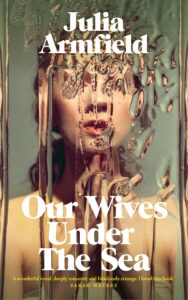Leah’s behavior is deeply unsettling since her return from an oceanic expedition. Mysteriously saturated with the sea, she roams their home in silence, soaking in the tub for days, isolating herself in the bathroom. This is mere shadow of the person Miri, her spouse, once knew.
The story unfurls through the lives of these two women – Miri, seeking solace with friends and yearning for answers from the cryptic organization responsible for the expedition, and Leah, haunted by the memory of her time spent underwater with her colleagues. As Miri frantically searches for the truth, Leah becomes increasingly enigmatic, her condition worsening as we journey deeper into the narrative. The novel is thoughtfully segmented, mirroring the levels of the ocean depths, from the innocuous upper “Sunlight Zone” to the ominous and treacherous “Hadal Zone.”
Leah’s recollections of her confining and disorienting ordeal at the bottom of the ocean intertwine with Miri’s desperate attempt to rediscover the Leah she once cherished, hidden behind this enigmatic aquatic divide. With its visceral blend of body horror and stark realism, “Our Wives Under the Sea” stands as one of the year’s most chilling tales—and it achieves this without a single jumpscare.
We had the chance to sit down with writer Julia Armfield to discuss her latest work, the ordinary reactions to the extraordinary, and the depiction of queer relationships within her novel.
What was the spark that led to this frightening story of a partner profoundly altered by the sea?
Inspired initially by a short story idea, the concept was influenced by Lauren Groff’s novel—its mix of familiar drama and fantastical elements. From the desire to explore themes of grief and queer relationships, the narrative took shape against a backdrop of strange and unsettling events. Armfield delves into the normalization of the extraordinary, how life’s routine prevails despite the most bizarre circumstances.
The heart of the novel lies in Miri’s struggle to recognize Leah, while Leah’s passages offer glimpses into her oceanic isolation. What’s the significance behind this contrast?
Duality was always intentional, with the book serving as a dialog between ascending and descending narratives. Symbolizing a submerging submarine, this duality was critical in addressing trauma and focusing on Leah and her experiences while presenting Miri as the means of wider exploration.
The novel excels in its haunting atmosphere over gore. Are you naturally drawn to this subtler form of horror?
While Armfield appreciates various horror subgenres, she is especially captivated by the power of dread—the agonizing wait before the shock. This theme of anticipatory terror weaves its way through the novel, emphasizing the fear of the unknown and projecting a sense of foreboding that resonates with readers.
The Centre, an organization connected to Leah’s fateful expedition, remains vague and uncooperative. Is there personal inspiration behind the portrayal of this faceless bureaucracy?
Armfield meticulously crafted the Centre’s maddening ambiguity to mirror the frustration of dealing with impersonal corporations and healthcare systems. It’s a play on the collision of surreal events with mundanity, illustrating how reality often tends toward the absurd and exasperating, rather than the grandiose.
Leah, partly seen as a “malfunctioning product,” complicates Miri’s quest for solutions. How does this analogy play into the story’s exploration of love and loss?
This perspective highlights a raw truth about grief—it is inherently rooted in our own sense of loss. Miri’s battle is against the dual forces of her love for Leah and the creeping realization that grief is an innately selfish, yet unavoidable response.

Utilizing the sea’s layers as a structural device reflects the narrative’s descent into darkness. What was the thought process behind this?
Armfield speaks of a “lightbulb moment” prompted by an illustrated online resource that simulated the descent through ocean layers. It became a perfect metaphor for the storyline’s progression, a descent into ever-darkening events and emotions.
Supplementing the grim reality of the novel are snippets of dark humor, such as roleplaying forums for spouses of astronauts or specialized congregations. How did you conceive these ironic details?
Armfield incorporates levity amidst despair — the absurdities of life that persevere even in catastrophic times. The humor emerges from an authentic depiction of life online and the real-world’s often inadequate, sometimes humorous attempts to cope with tragedy and provide comfort.
In envisioning Leah at sea’s depths, what was the process for depicting an environment you’ve never encountered?
Research informed a realistic, albeit not exhaustive, background. Important for Armfield was the atmospheric sensation of being in an unsettling confined space, less about the mechanics and more about the unnerving experience akin to a haunted house.
Discussing research practices, how did you balance factual foundation with creative storytelling?
Armfield’s approach was not to overburden the narrative with research, but to enrich the story with fascinating details. She believes in the delicate balance of accurately capturing a scene while keeping the reader immersed in the fiction.
Did delving into deep sea research leave you with any surprising or startling discoveries?
The writer was particularly taken aback by filmmaker James Cameron’s own deep-sea explorations, a somewhat unexpected revelation given his career.
With the upcoming U.S. release, what’s next on your creative horizon?
Armfield is in the early stages of a new novel, likened to a stew in the making—with its ultimate direction still to be determined and the hope for a pleasing final blend.